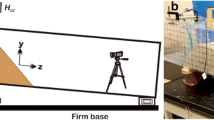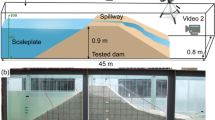Abstract
Landslide dam failure can trigger catastrophic flooding in the downstream. However, field observation of such flooding is rarely available, while laboratory experimental studies are sparse. The mechanism of landslide dam failure and the flood has so far remained insufficiently understood. Here, we present an experimental investigation of landslide dam failure and the flood. A total of 28 runs of experiments are carried out in a flume of 80 m × 1.2 m × 0.8 m, with differing inflow discharge, dam composition, dam geometry, and initial breach dimension. An array of twelve automatic water-level probes is deployed to measure the stage hydrographs along the flume, and the video recording of the dam failure processes facilitates an estimation of the widening of initial breach. Under the present experimental conditions with dams composed of homogeneous materials, landslide dam failure is primarily caused by erosion of overtopping flow, and lateral mass collapse is also considerable during the cause of breach widening. Cohesive clay may act to mitigate the seepage through the dam and thus its subsidence and appreciably modulate the dam failure process and the flood. However, the impacts of clay may be readily overwhelmed by a large inflow discharge and initial breach. Gravels in the dam may appreciably depress the rate of the dam failure process and thus modify the flood. The present work provides new experimental data set for testing mathematical models of the flood flow due to landslide dam failure.











Similar content being viewed by others
Abbreviations
- H :
-
Initial dam height (cm)
- H b :
-
Depth of initial breach (cm)
- H d :
-
Initial static water depth at downstream of the dam (cm)
- H f :
-
Maximum residual thickness upon the completion of the dam failure (cm)
- H u :
-
Initial static water depth at upstream of the dam (cm)
- Q :
-
Inflow discharge from the far upstream (m3/s)
- S1, S2:
-
Initial upstream and downstream slopes of the dam (−)
- t :
-
Time (s)
- T :
-
Time from the onset to the completion of the dam failure (s)
- T b :
-
Time for the stage in front of the dam to rise up to the peak stage (s)
- T bg :
-
Time for the initial breach to grow laterally to the full width of the channel (s)
- V :
-
Dam volume (m3)
- W :
-
Initial width of the dam crest (cm)
- W b :
-
Base width of initial breach (cm)
References
Abril B, Knight D (2004) Stabilising the Paute river in Ecuador. Civ Eng Proc Inst Civ Eng 157(1):32–38
Allen J (1952) Scale models in hydraulic engineering. Longman, London
Balmfroth NJ, Hardenberg J, von Provenzale A, Zammett R (2008) Dam breaking by wave-induced erosional incision. J Geophys Res 113(F01020). doi:10.1029/2007JF000756
Balmfroth NJ, von Hardenberg J, Zammett R (2009) Dam-breaking seiches. J Fluid Mech 628:1–21
Bovis M, Jakob M (2000) The July, 1998, debris flow and landslide dam at Capricorn Creek, Mount Meager Volcanic Complex, southern Coast Mountains, British Columbia. Can J Earth Sci 37(10):1321–1334
Cao ZX, Pender G, Wallis S, Carling P (2004) Computational dam-break hydraulics over erodible sediment bed. ASCE J Hydraul Eng 130(7):689–703
Cao ZX, Yue ZY, Pender G (2011) Landslide dam failure and flood hydraulics. Part II: coupled mathematical modelling. Nat Hazards. doi:10.1007/s11069-011-9815-7
Capart H, Young DL (1998) Formation of a jump by the dam-break wave over a granular bed. J Fluid Mech 372:165–187
Carrivick JL (2010) Dam break-outburst flood propagation and transient hydraulics: a geosciences perspective. J Hydrol 380(3–4):338–355
Cenderelli DA, Wohl EE (2001) Peak discharge estimates of glacial-lake outburst floods and ‘normal’ climatic floods in the Mount Everest region, Nepal. Geomorphology 40(1–2):57–90
Cenderelli DA, Wohl EE (2003) Flow hydraulics and geomorphic effects of glacial-lake outburst floods in the Mount Everest region, Nepal. Earth Surf Process Landf 28(4):385–407
Chen YJ, Zhou F, Feng Y, Xia YC (1992) Breach of a naturally embanked dam on Yalong River. Can J Civ Eng 19(5):811–818
Chinnarasri C, Tingsanchali T, Weesakul S, Wongwises S (2003) Flow patterns and damage of dike overtopping. Int J Sed Res 18(4):301–309
Coleman SE, Andrews DP, Webby MG (2002) Overtopping breaching of noncohesive homogeneous embankments. ASCE J Hydraul Eng 128(9):829–838
Costa JE, Schuster RL (1988) The formation and failure of natural dams. Geol Soc Am Bull 100(7):1054–1068
Cruden DM, Keegan TR, Thomson S (1993) The landslide dam on the Saddle River near Rycroft, Alberta. Can Geotech J 30(6):1003–1015
Cruden DM, Lu ZY, Thomson S (1997) The 1939 Montagneuse River landslide, Alberta. Can Geotech J 34(5):799–810
Cui P, Zhu Y, Han Y, Chen X, Zhuang J (2009) The 12 May Wenchuan earthquake-induced landslide lakes: distribution and preliminary risk evaluation. Landslides 6(3):209–223
Dai FC, Lee CF, Deng JH, Tham LG (2005) The 1786 earthquake-triggered landslide dam and subsequent dam-break flood on the Dadu River, southwestern China. Geomorphology 65(3–4):205–221
Davies TR, Manville V, Kunz M, Donadini L (2007) Modeling landslide dam break flood magnitudes: case study. ASCE J Hydraul Eng 133(7):713–720
Hoeg K (1998) New dam safety legislation and the use of risk analysis. Int J Hydrop Dams 5(5):85–89
Hoeg K, Lovoll A, Vaskinn KA (2004) Stability and breaching of embankment dams: field tests on 6 m high dams. Int J Hydropower Dams 11(1):88–92
Hu XW, Lu XP, Huang RQ, Shi YB, Liu J, Li YB (2009) Developmental features and evaluation of blocking dangers of Dashui ditch debris flow in Tangjiashan dammed lake. Chin J Rock Mech Eng 28(4):850–858
Korup K (2002) Recent research on landslide dams - a literature review with special attention to New Zealand. Progress Phys Geogr 26(2):206–235
Korup K, Tweed F (2007) Ice, moraine, and landslide dams in mountainous terrain. Quat Sci Rev 26(25–28):3406–3422
Li TC, Schuster RL, Wu JS (1986) Landslide dams in south-central China. In: Schuster R (ed) Landslide dams: processes, risk and mitigation. Geotechnical Special Publication No. 3, ASCE, pp 146–162
Liu SZ, Li HX, Yan Y, Chai ZX, Du SP (2003) Assessment of bursting hazards of the ice lakes in Luozha County, Tibet. J Mt Sci 21:128–132
Miller BGN, Cruden DM (2002) The Eureka River landslide and dam, Peace River Lowlands, Alberta. Can Geotech J 39(4):863–878
Morris M (2009) Breaching processes: a state of art review. FLOODsite Project Report T06-06-03. FLOODsite, www.floodsite.net
Nicoletti PG, Parise M (2002) Seven landslide dams of old seismic origin in southeastern Sicily (Italy). Geomorphology 46(3–4):203–222
O’Connor JE, Baker VR (1992) Magnitudes and implications of peak discharges from glacial lake Missoula. Geol Soc Am 104(3):267–279
Shang YJ, Yang ZF, Li LH, Liu DA, Liao QL, Wang YC (2003) A super-large landslide in Tibet in 2000: background, occurrence, disaster and origin. Geomorphology 54(3–4):225–243
Shen YP, Ding YJ, Liu SY, Wang SD (2004) An increasing glacial lake outburst flood in Yarkant River, Karakorum in past ten years. J Glaciol Geocryol 26(2):117
Zhu YH, Visser PJ, Vrijling JK (2006) Laboratory observations of embankment breaching. In: Proceeding of the 7th ICHE congress, September, Philadelphia, USA
Acknowledgments
This investigation is funded by National Key Basic Research and Development Program (973 Program) of China (Grant No. 2007CB714106), and Natural Science Foundation of China (Grant No. 10932012, 10972164).
Author information
Authors and Affiliations
Corresponding author
Rights and permissions
About this article
Cite this article
Cao, Z., Yue, Z. & Pender, G. Landslide dam failure and flood hydraulics. Part I: experimental investigation. Nat Hazards 59, 1003–1019 (2011). https://doi.org/10.1007/s11069-011-9814-8
Received:
Accepted:
Published:
Issue Date:
DOI: https://doi.org/10.1007/s11069-011-9814-8




